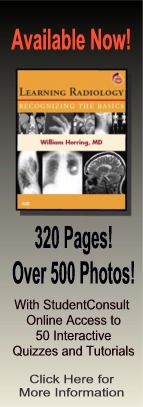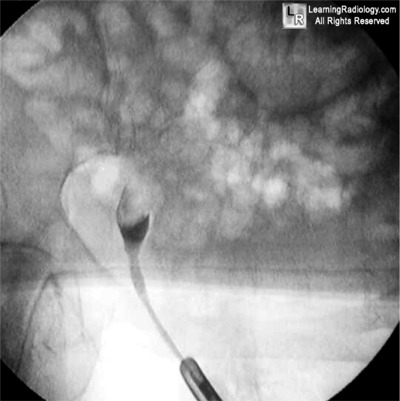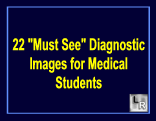| Cardiac | |
|---|---|
| GI | |
| Bone | |
| GU | |
| Neuro | |
| Peds | |
| Faculty | |
| Student | |
| Quizzes | |
| Image DDX | |
| Mobile | |
| |
Misc |
| Videocasts | |
What sign is depicted on this image?
- 73 year-old with hematuria and pain
1. Giblet sign
2. Egg-on-a-string sign
3. Goblet sign
4. Pencil-in-cup sign
5. Comet sign
Additional Images - None
![]()
Additional Images
.
None
![]()
Answer:
.
3. Goblet sign
.
.
More (Click Discussion Tab)
Goblet Sign
General Considerations
- Transitional cell carcinoma accounts for 85-90% of all uroepithelial tumors
- Exophytic, polypoid papillary growth pattern most common
- Attached to the mucosa by stalk
- Non-papillary tumors less common
- Most are solid with no characteristic gross findings
- Location
- Bladder is 30-50x more often the site of the tumor than ureter or renal pelvis (most common tumor of GU tract)
- When it occurs in the ureter, it most commonly occurs in the lower 3rd
.
This Week
73 year-old with hematuria and pain |
Part 1 reviews 50 imaging signs, offers a description and example of each and names at least one disease in which the sign can be found |
Review descriptions of key imaging signs in the shorthand of Tweets by subscribing to this new LearningRadiology Twitter feed for your computer or cell phone
|
Key points on recognizing the most common fractures and dislocations |
Basic CT imaging of the brain focusing on the findings of cerebrovascular accidents |
The top diagnostic imaging diagnoses that all medical students should recognize according to the Alliance of Medical Student Educators in Radiology |
Recognizing normal and key abnormal intestinal gas patterns, free air and abdominal calcifications |
Some of the fundamentals of interpreting chest images |
| LearningRadiology.com |
is an award-winning educational website aimed primarily at medical students and radiology residents-in-training, containing lectures, handouts, images, Cases of the Week, archives of cases, quizzes, flashcards of differential diagnoses and “most commons” lists, primarily in the areas of chest, GI, GU cardiac, bone and neuroradiology. |



